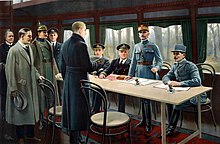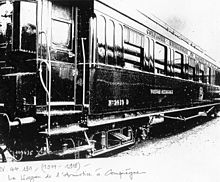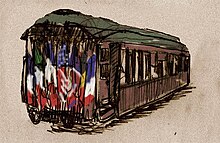Compiègne car

The Compiègne car is the former dining car and later saloon car in which in November 1918 the end of the fighting between the German Empire and the Entente armed forces was agreed in a clearing near Compiègne ( First Armistice of Compiègne ). In June 1940, France's surrender to the German Reich was signed there and in the same car ( Compiègne Second Armistice ).
history
First World War and the aftermath
The dining car with the no.2419 D was built in 1914 in Saint-Denis with 21 similar cars for the Compagnie Internationale des Wagons-Lits (CIWL) in their workshops, delivered on May 20 and was as such from June 4 to 3. August 1914 in use according to schedule. When the war began, the car was parked at the Champ de Mars - Tour Eiffel station and later in Clichy . In July 1915 it ran again between Paris and Le Mans , after an overhaul in Saint-Denis it was still used as planned on routes departing from Paris.
In autumn 1918, the management of the CIWL pulled the dining car to form a command platoon for Marshal Foch's general staff and had it converted into his office beforehand. The car was divided into a larger and a smaller hall, the larger one contained a 2.5 × 1.5 m² table. The handover to the General Staff took place on October 29, 1918 in Senlis . The train consisted moreover of a sleeper and a lounge car and to protect cars were one at each end of the train van set. The Marshal used this train from late October 1918 to September 1919.
On November 11, 1918, after four days of negotiations in this mobile office of the Commander-in-Chief of the Entente, the armistice for the Western Front was signed, which ended the First World War . This made the 2419 D the “Car from Compiègne”. Marshal Foch also used the car in the armistice negotiations on December 16, 1918, January 13 and February 16, and April 13 and 14, 1919 in Spa . In September 1919, the army lifted the seizure. The CIWL donated the vehicle to the French Republic in September 1919 on an instruction from General Joseph Gassouin . Georges Clemenceau accepted the "gift" on October 7, 1919, the CIWL deleted the car on January 3, 1920 from their inventory. The state first put the vehicle back into the dining car and temporarily used it in the presidential train, among other things, on December 8, 1920, President Alexandre Millerand dined with many guests of honor on the journey to Verdun , where he inaugurated the bayonet trench as a national memorial.
Then the car was rebuilt again, this time to the stand it had on November 11, 1918, and placed in the courtyard of the Army Museum in Paris . To do this, because it was too wide, some columns in the area of the entrance to the Hôtel des Invalides , where the museum is housed, had to be temporarily hollowed out. He stayed there from April 29, 1921 to April 8, 1927, but weathered increasingly. The museum allegedly did not have the means to restore it.
On the initiative of the Mayor of Compiègne and with the support of the American Arthur Henry Fleming, the car was restored and housed in a specially constructed museum building on the Clairière de l'Armistice ("Armistice clearing").
Second World War and the aftermath
To sign the armistice between the German Reich and France on June 22, 1940, Hitler had the vehicle taken out of the building and put back in the clearing near Compiègne. The car was then taken on the street to Berlin (it was no longer roadworthy) and exhibited at the Berlin Cathedral for a week , then stored in a shed. In 1944 the car came to Thuringia , was first parked in Ruhla and later driven via Gotha to Crawinkel , near the Jonastal tunnel . There it was probably destroyed by the SS in March 1945 in view of the approaching US Army . But there are also other opinions that the car could have been destroyed by a plane attack , former prisoners of the Ohrdruf forced labor camp or by the civilian population. The last two versions are supported by testimony that the car was only set on fire in April, when the American 89th Infantry Division had already occupied Ohrdruf.
On September 16, 1950, a similar car (original number: 2439) was set up on the Clairière de l'Armistice .
Where the wreck was located after 1945
The substructure of the car probably survived the fire and was converted into a works car after the end of the war in the Soviet occupation zone and GDR . After a pause, the use of cars in the 1970s was again rebuilt and as a works car No 17. Weichenwerk of Gotha used; Because of its soft suspension , it was nicknamed the sofa . The only indication of the origin of the car substructure were letters cast in the axle box covers. After a damage, the car was scrapped in 1986.
Impressions from Crawinkel and Compiègne
literature
in alphabetical order by authors / editors
- Jean de Cars: Sleeper. International Express Trains: A Hundred Years of Travel and Adventure . Stuttgart 1984. ISBN 3-613-01028-3 (here: Chapter 9: From one war to another. The armistice car ).
- Daniel Hörnemann: Wagons of Fate - Destiny of the Wagons . In: Eisenbahngeschichte 91 (December 2018 / January 2019), pp. 20–23.
- Dankmar Leffler / Klaus-Peter Schambach, Secret Journey to the Fourth Reich? The legendary Compiègne railway carriage, Crawinkel 2006
- Mémorial de L'Armistice (ed.): 1918 and 1940. The signing of the Armistice in the forest glade of Compiegne . Compiègne 2013.
- Heinz-Siegfried Strelow: The last trip led into the forest of Ohrdruf . In: Thüringer Landeszeitung from October 31, 1992.
Web links
Individual evidence
- ↑ Cars: Schlafwagen , p. 144.
- ↑ Cars: Schlafwagen , p. 144 f.
- ↑ Cars: Schlafwagen , p. 147 ff.
- ↑ Cars: Schlafwagen , p. 149 f.
- ↑ Cars: Schlafwagen , p. 151 f.
- ↑ Cars: Schlafwagen , p. 152f.
- ↑ Memorial of L'Armistice (ed.): 1918 and 1940. The signing of the Armistice in the forest glade of Compiegne . Compiègne 2013, p. 26 f.
- ↑ Heinz-Siegfried Strelow: The last trip led into the forest of Ohrdruf . In: Thüringer Landeszeitung from October 31, 1992.
- ↑ Cars: Schlafwagen , p. 154.
- ↑ Memorial of L'Armistice (ed.): 1918 and 1940. The signing of the Armistice in the forest glade of Compiegne . Compiègne 2013, p. 29.
- ↑ Memorial of L'Armistice (ed.): 1918 and 1940. The signing of the Armistice in the forest glade of Compiegne . Compiègne 2013, p. 27.









